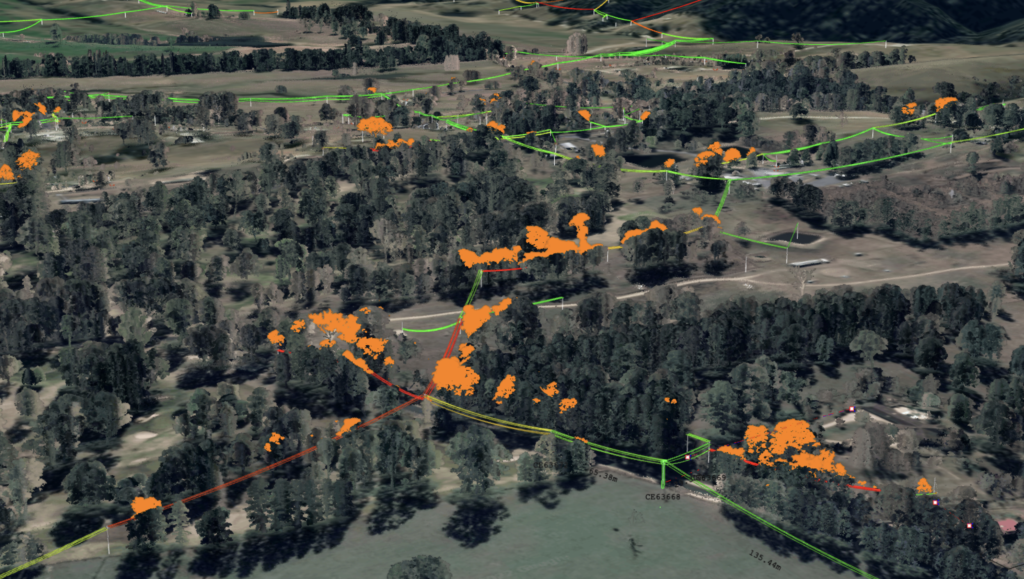
Case Study: Building Resilience to Improve Reliability and Reduce Outages for a Large East Coast Utility
Context
A large East Coast utility launched a resilience initiative to strengthen its electric distribution system by enhancing grid reliability, operational efficiency, and asset visibility. The program was designed to move the network away from reactive maintenance and toward a data-driven, proactive model. At its core, the initiative integrates high-resolution LiDAR, imagery, and advanced analytics into a connected, physics-based model of the network. By doing so, the utility aims to reduce customer outages, improve the accuracy of asset and vegetation data, and increase confidence in long-term capital planning.
Alongside financial and reliability gains, the initiative also promises safer field operations, extended asset life, better project planning, improved customer satisfaction, and a reduction in System Average Interruption Duration Index (SAIDI) minutes— all grounded in a unified source of truth for grid and vegetation data.
The Problem
Like many utilities, this network faced reliability challenges driven by vegetation and aging assets. Outage records showed that a large share of customer minutes came from hard-to-reach circuits, where storms, dense vegetation, and equipment failures combined to drive repeat interruptions. Vegetation encroachment and fall-in from dead trees outside the right-of-way remained leading causes of outages, yet trimming cycles were still largely schedule-based rather than risk-driven.
Meanwhile, fragmented datasets made it difficult to plan or prioritize effectively. GIS inaccuracies generated more than twenty thousand redline requests each year, burdening engineers and delaying projects. Pole inspections for aging infrastructure — including CCA poles — relied on costly and time-consuming truck rolls, straining field resources at a time when inspection mandates were expanding. Oversight of joint-use attachments posed another challenge: undocumented or non-compliant equipment created structural risks, but the process to identify them was slow, manual, and difficult to scale. Together, these issues left the utility exposed to avoidable outages, rising costs, and regulatory scrutiny over the cost-effectiveness of its reliability investments.
The Solution & Outcome
The resilience initiative piloted with Neara spanned across more than 3,200 miles of distribution network in three diverse regions. Using Neara’s physics-enabled digital twin, the utility created a 3D structural model of poles, conductors, and spans, overlaid with vegetation and environmental data. The model allowed teams to simulate pole loading under National Electrical Safety Code (NESC) standards and extreme conditions such as wind and ice, run clearance checks, and pinpoint vegetation encroachment and fall-in risks at the span level.
The pilot replaced manual inspection estimates with automated, engineering-grade analyses. Vegetation analytics segmented individual trees and mapped canopy overhangs, enabling trimming to be prioritized by risk severity and outage history rather than fixed cycles. Pole loading simulations identified overstressed or leaning structures, while GIS reconciliation automatically detected missing or misaligned assets, reducing the need for repeated field surveys. Joint-use audits traced third-party attachments across spans, supported load assessments before new telecom permitting, and provided evidence for potential cost recovery.
The benefits were clear. By reducing redundant truck rolls and focusing fieldwork on the highest-priority risks, the utility improved efficiency and safety. More accurate data reduced redline volumes and improved the foundation for Fault Location, Isolation, and Service Restoration (FLISR) enablement. For regulators, the physics-based outputs provided quantifiable, defensible evidence of risk reduction, tying mitigation efforts directly to measurable reliability improvements.
By 2033, the resilience initiative is expected to deliver more than $54 million in annual benefits, including a 6% reduction in SAIDI and 20 million fewer outage minutes each year. Approximately $50 million of those benefits come from avoided outages through targeted vegetation and equipment analytics, while an additional $7.5 million annually is tied to avoided project overruns thanks to better survey data. Asset health analysis is projected to generate over $2 million per year by reducing vendor inspection costs and extending pole life through earlier detection of risks.
What began as a pilot evolved into a clear proof of concept: a physics-based, LiDAR-first model that shifts the utility from reactive maintenance to proactive reliability management. The result is a safer, more resilient network, supported by defensible data, improved customer satisfaction, and stronger regulatory confidence in capital planning.